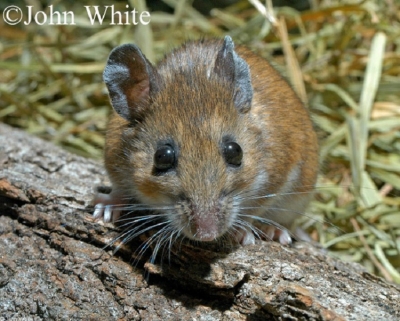White Footed Deermouse, Peromyscus-leucopus
The White Footed Deermouse is a mouse which occurs state-wide, is one of the most abundant mammals in the forests of Tennessee.
Description:
A small rodent with large, black eyes, large ears, and long, coarse whiskers. The color usually ranges from grayish to reddish-brown above, often with a darker band down the center of the back. The feet, lower part of the face, and the undersides are white, which sharply contrasts from upper color. Sparsely furred tails have a darker upper half and lighter lower half but do not have a sharp contrast between the two surfaces. Tails are about one-half the total length of the body and lack a tuft of hairs at the tip.
Length: 5.5 - 8.4 inches
Tail: 2.5 - 4.0 inches
Ears: 0.6 - 0.8 inches
Weight: 0.4 - 1.0 ounces
Similar Species:
White-footed Deermouse cannot reliably be separated from North American Deermouse and Cotton Deermouse without a detailed analysis of skull and dental formations, and possibly an expert.
Habitat:
Primarily found in forests and around forest edges, but can be found in a variety of habitats including scrubland, and fencerows.
Diet:
Omnivorous; primarily eating seeds, nuts, fruits, berries, insects, and grains when available. One of its favorite foods is black cherry pits.
Breeding information:
The peak of the White-footed Deermouse breeding activity is early spring through late summer. Some females may have as many as 5 litters per year. Gestation lasts 22-25 days and typically 1-8 young (average 4) are born per litter. Newborn are blind, pink, and weight about 2 grams. Females nurse them until they are weaned at 2-3 weeks old.
Status in Tennessee:
A common species in woodland habitat; no conservation concerns.

Fun Facts:
•White-footed Deermice often convert old bird nests into homes by constructing roofs on top of them.
•They are good climbers and spend a large part of their lives in trees.
Best places to see in Tennessee:
Along the edges of woodlands or fencerows with scattered brush piles.
Sources:
Schwartz, C.W. and E.R. Schwartz. 2001. The Wild Mammals of Missouri, 2nd Edition. University of Missouri Press and Missouri Department of Conservation, Columbia, MO.